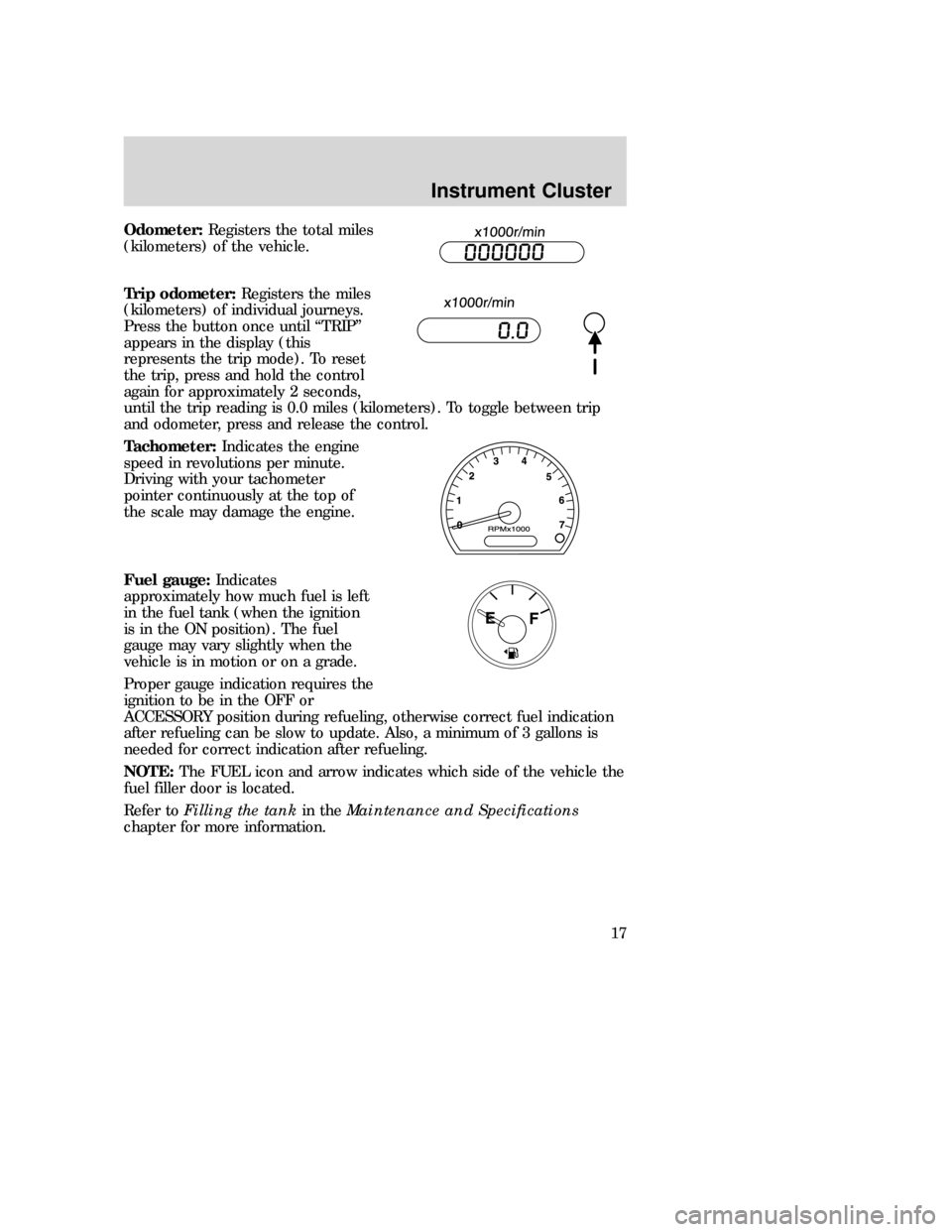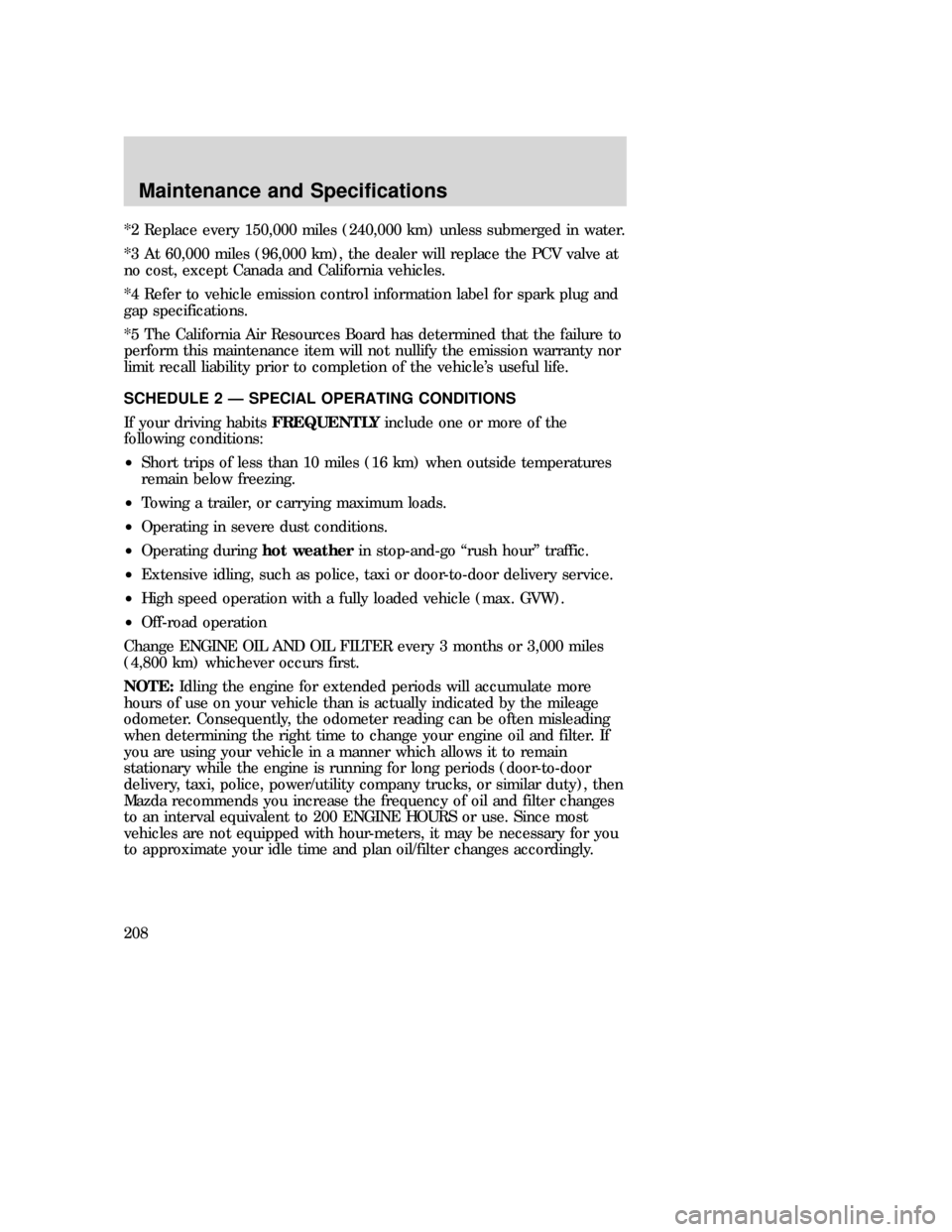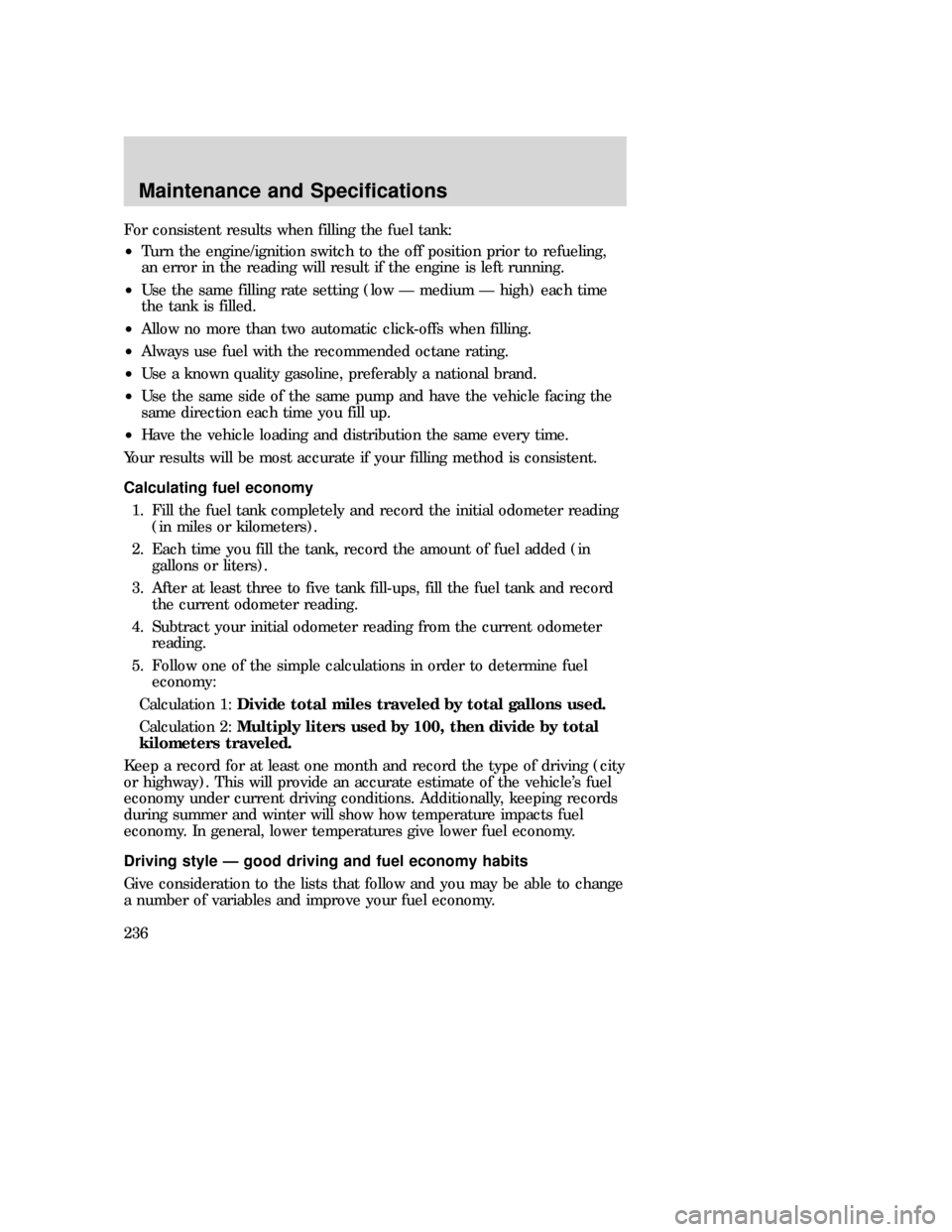odometer MAZDA MODEL B-SERIES 2006 Owners Manual (in English)
[x] Cancel search | Manufacturer: MAZDA, Model Year: 2006, Model line: MODEL B-SERIES, Model: MAZDA MODEL B-SERIES 2006Pages: 262, PDF Size: 2.47 MB
Page 17 of 262

Odometer:Registers the total miles
(kilometers) of the vehicle.
Trip odometer:Registers the miles
(kilometers) of individual journeys.
Press the button once until “TRIP”
appears in the display (this
represents the trip mode). To reset
the trip, press and hold the control
again for approximately 2 seconds,
until the trip reading is 0.0 miles (kilometers). To toggle between trip
and odometer, press and release the control.
Tachometer:Indicates the engine
speed in revolutions per minute.
Driving with your tachometer
pointer continuously at the top of
the scale may damage the engine.
Fuel gauge:Indicates
approximately how much fuel is left
in the fuel tank (when the ignition
is in the ON position). The fuel
gauge may vary slightly when the
vehicle is in motion or on a grade.
Proper gauge indication requires the
ignition to be in the OFF or
ACCESSORY position during refueling, otherwise correct fuel indication
after refueling can be slow to update. Also, a minimum of 3 gallons is
needed for correct indication after refueling.
NOTE:The FUEL icon and arrow indicates which side of the vehicle the
fuel filler door is located.
Refer toFilling the tankin theMaintenance and Specifications
chapter for more information.
2006 B-Series(mbs)
Owners Guide (post-2002-fmt)
Canadian_French(fr_can)
Instrument Cluster
17
Page 189 of 262

4. Purchase date.
5. Present odometer reading.
6. Your authorized dealer’s name and location
7. The nature of your problem and/or cause of dissatisfaction.
The Department, in cooperation with the local Mazda Service
Representative, will review the case to determine if everything possible
has been done to ensure your satisfaction.
Please recognize that the resolution of service problems in most cases
requires the use of your authorized dealer’s service facilities, personnel
and equipment. We urge you to follow the above three steps in sequence
therefore for most effective results.
Mediation/Arbitration Program
Occasionally a customer concern cannot be resolved through Mazda’s
Customer Satisfaction Program. If after exhausting procedures in this
manual, your concern is still not resolved, you have another option.
Mazda Canada Inc. participates in an arbitration program administered
by the Canadian Motor Vehicle Arbitration Plan (CAMVAP). CAMVAP will
advise you about how your concern may be reviewed and resolved by an
independent third party through binding arbitration.
Your complete satisfaction is the goal of Mazda Canada Inc. and our
authorized dealers. Mazda’s participation in CAMVAP makes a valuable
contribution to our achieving that goal. There is no charge for using
CAMVAP. CAMVAP results are fast, fair and final as the award is binding
on both you and Mazda Canada Inc.
Canadian Motor Vehicle Arbitration Plan (CAMVAP)
For vehicles delivered to authorized Canadian dealerships. If a specific
item of concern arises, where a solution cannot be reached between an
owner, Mazda, and/or one of it’s authorized dealers (that all parties
cannot agree upon), the owner may wish to use the services offered by
the Canadian Motor Vehicle Arbitration Plan (CAMVAP).
CAMVAP uses the services of Provincial Administrators to assist
consumers in scheduling and preparing for their arbitration hearings.
However, before you can proceed with CAMVAP you must follow your
Mazda dispute resolution process as outlined previously.
2006 B-Series(mbs)
Owners Guide (post-2002-fmt)
Canadian_French(fr_can)
Customer Assistance
189
Page 208 of 262

*2 Replace every 150,000 miles (240,000 km) unless submerged in water.
*3 At 60,000 miles (96,000 km), the dealer will replace the PCV valve at
no cost, except Canada and California vehicles.
*4 Refer to vehicle emission control information label for spark plug and
gap specifications.
*5 The California Air Resources Board has determined that the failure to
perform this maintenance item will not nullify the emission warranty nor
limit recall liability prior to completion of the vehicle’s useful life.
SCHEDULE 2 — SPECIAL OPERATING CONDITIONS
If your driving habitsFREQUENTLYinclude one or more of the
following conditions:
•Short trips of less than 10 miles (16 km) when outside temperatures
remain below freezing.
•Towing a trailer, or carrying maximum loads.
•Operating in severe dust conditions.
•Operating duringhot weatherin stop-and-go “rush hour” traffic.
•Extensive idling, such as police, taxi or door-to-door delivery service.
•High speed operation with a fully loaded vehicle (max. GVW).
•Off-road operation
Change ENGINE OIL AND OIL FILTER every 3 months or 3,000 miles
(4,800 km) whichever occurs first.
NOTE:Idling the engine for extended periods will accumulate more
hours of use on your vehicle than is actually indicated by the mileage
odometer. Consequently, the odometer reading can be often misleading
when determining the right time to change your engine oil and filter. If
you are using your vehicle in a manner which allows it to remain
stationary while the engine is running for long periods (door-to-door
delivery, taxi, police, power/utility company trucks, or similar duty), then
Mazda recommends you increase the frequency of oil and filter changes
to an interval equivalent to 200 ENGINE HOURS or use. Since most
vehicles are not equipped with hour-meters, it may be necessary for you
to approximate your idle time and plan oil/filter changes accordingly.
2006 B-Series(mbs)
Owners Guide (post-2002-fmt)
Canadian_French(fr_can)
Maintenance and Specifications
208
Page 236 of 262

For consistent results when filling the fuel tank:
•Turn the engine/ignition switch to the off position prior to refueling,
an error in the reading will result if the engine is left running.
•Use the same filling rate setting (low — medium — high) each time
the tank is filled.
•Allow no more than two automatic click-offs when filling.
•Always use fuel with the recommended octane rating.
•Use a known quality gasoline, preferably a national brand.
•Use the same side of the same pump and have the vehicle facing the
same direction each time you fill up.
•Have the vehicle loading and distribution the same every time.
Your results will be most accurate if your filling method is consistent.
Calculating fuel economy
1. Fill the fuel tank completely and record the initial odometer reading
(in miles or kilometers).
2. Each time you fill the tank, record the amount of fuel added (in
gallons or liters).
3. After at least three to five tank fill-ups, fill the fuel tank and record
the current odometer reading.
4. Subtract your initial odometer reading from the current odometer
reading.
5. Follow one of the simple calculations in order to determine fuel
economy:
Calculation 1:Divide total miles traveled by total gallons used.
Calculation 2:Multiply liters used by 100, then divide by total
kilometers traveled.
Keep a record for at least one month and record the type of driving (city
or highway). This will provide an accurate estimate of the vehicle’s fuel
economy under current driving conditions. Additionally, keeping records
during summer and winter will show how temperature impacts fuel
economy. In general, lower temperatures give lower fuel economy.
Driving style — good driving and fuel economy habits
Give consideration to the lists that follow and you may be able to change
a number of variables and improve your fuel economy.
2006 B-Series(mbs)
Owners Guide (post-2002-fmt)
Canadian_French(fr_can)
Maintenance and Specifications
236